NO TIME TO DIE Countdown: GOLDFINGER Revisited
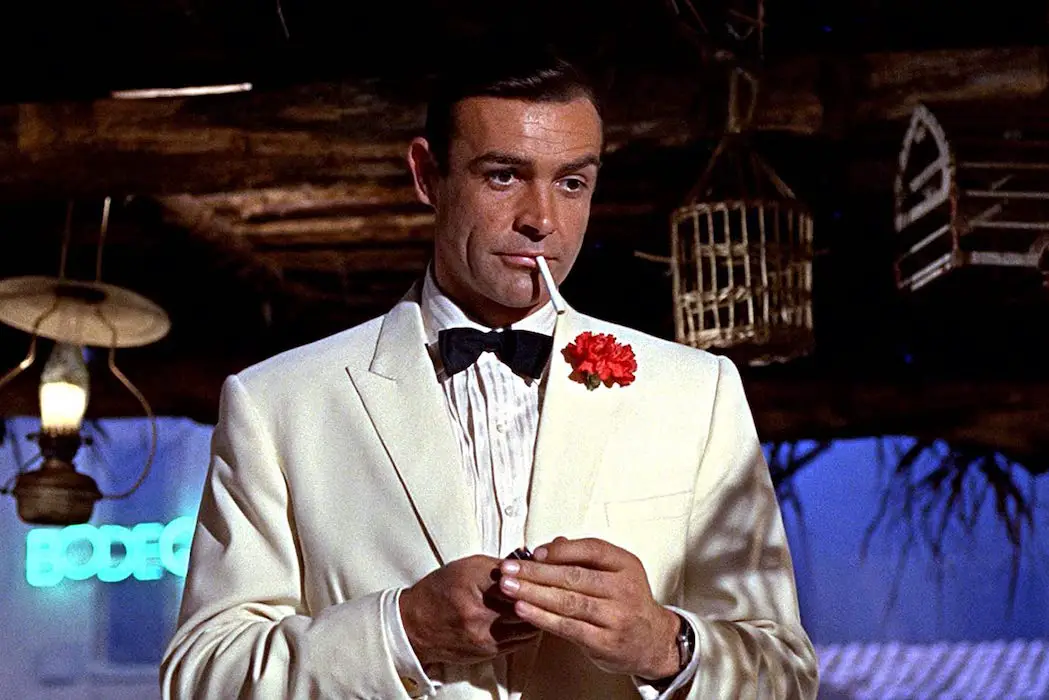
Movie lover & Los Angeles-based writer. BA in Film Criticism…
In the No Time To Die Countdown, Jake Tropila takes a look back at every Bond film – official and unofficial – in anticipation of the release of the latest entry.
Here we are: the quintessential James Bond Film. The villain, the girl, the henchman, the plot, the car, the gadgets, the song, the laser, even the manner of death – everyone and everything about Bond coalesces here, perfecting the formula established by its predecessors and launching the series to stratospheric new heights. Goldfinger (the first part of its title is aptly named) boldly takes Bond bigger and better than ever, delivering an exhilarating entry comprised of many of the series’ greatest hits.
The influence is not solely limited to Bond, either. Fifty-six years on and the weight of Goldfinger still resonates within movies today, frequently the object of homage, parody, and countless spoofs (between this and You Only Live Twice, much of the Austin Powers Cinematic Universe would not exist). For a salient point, look no further than the corpse of Shirley Eaton’s Jill Masterson: nude, face-down, and covered head to toe in gilded paint. Certainly, one of the most indelible images in cinematic history, if you ask me.
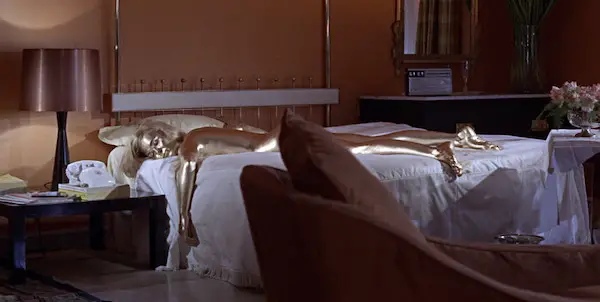
Admittedly, as much as I adore this movie – and having just re-watched it, I can affirm that it is, in fact, still steeped in greatness – I must take a moment to lament the shift from spy film to blockbuster. Dr. No and From Russia with Love were exquisitely thrilling in their own, understated ways, but audiences will always be left wanting more. And so, the ejector seat is born, tossing subterfuge out the window and paving the way for future gadgets and eye-popping set-pieces. Not to say that future installments don’t return to spy territory; they’re just few and far in between. Jetpacks and deadly piranhas will soon become the norm. C’est la vie.
Many will cite Goldfinger as the apotheosis of Bond. Is it a marvelous film? Absolutely. But is it the single best one there is? Not quite. A few minor gripes arise in the second half (and we’ll get to those), but they ultimately do little in the way of hampering the film’s brisk pace and immense sense of fun. Without further ado, let’s hop in our private jet and fly back to 1964 to meet the man with an expensive name.
Happenstance, Coincidence, Enemy Action
The pre-title sequence is a perfect showcase for character of Bond, offering a rousing micro-adventure completely divorced from the rest of the film’s plot. Using a fake duck head, grappling hook, and wetsuit, Bond successfully infiltrates a heroin plant, rigs the inventory to explode with C-4, and makes his getaway in an immaculate white dinner jacket, complete with a red carnation. He doesn’t even flinch while the explosion goes off behind him. Connery plays the part very relaxed throughout the film – even when threatened at gunpoint, he never loses his cool. The role must fit like a familiar glove at this point.
Rather than heed his ally’s warnings, Bond pursues a dalliance with a gorgeous belly dancer in his hotel room, which nearly proves to be a fatal mistake. Fortunately, reflective eyeballs save the day. Bond dodges his would-be assailant’s attack, knocks him into the bath, and fries him with an electric heat lamp. As Bond departs, he can’t help but let out a classic one-liner: “Shocking. Positively shocking.” A kiss, a kill, and a quip – James Bond in a nutshell. Cue title sequence.
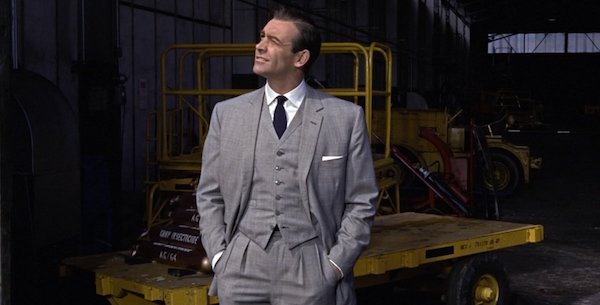
Bow down before the mighty Shirley Bassey. A brassy boss of a song by a brassy boss of a lady, “Goldfinger” is an exceptionally powerful title track, frequently climbing to the top of many “Best Of” lists. No arguments from me here; I’m firmly with the majority, and can’t help but be filled with glee whenever I hear that opening horn section. It’s no surprise that Bassey would be ask to return to do two more films.
Bond films rarely get their due for their formal rigor, but I’d like to take a moment to marvel at this next sequence of shots, however mundane they initially appear to be. First, a shot of a plane flying a banner that reads “WELCOME TO MIAMI BEACH,” establishing location. This shot then dissolves into an aerial tracking shot to a hotel pool, where a diver makes a leap off the highest point of the diving board. Just as he hits the water, we cut to a profile shot of this occurring from an observation window (which is technically “below” the pool’s surface), where the camera pans over to reveal Felix Leiter (played here by Cec Linder), strolling into the pool area.
I just can’t but feel giddy watching such a clean sequence of establishing shots. For the third Bond feature, Guy Hamilton takes over directing duties from Terence Young, and while he would go on to helm three more films in the series, Goldfinger remains his finest hour.
Bond is relaxing poolside, but it’s back to business once Leiter shows up, and this time he’s got a corker of a mission for him. Enter Auric Goldfinger, played with gusto by Gert Fröbe. A greedy menace shielded by a thick veneer of hospitality, Goldfinger places high in Bond’s rogues’ gallery, and rightfully so: he’s a big, bad man with a big, bad plan, but he’s also such a jovial screen presence that one can’t help but delight in the infectious energy he radiates. Goldfinger may be evil, but he sure is fun to watch. Even more impressive? With the exception of two words – “Except crime!” – Fröbe’s entire performance is seamlessly dubbed over by another actor. Wrap your head around that.
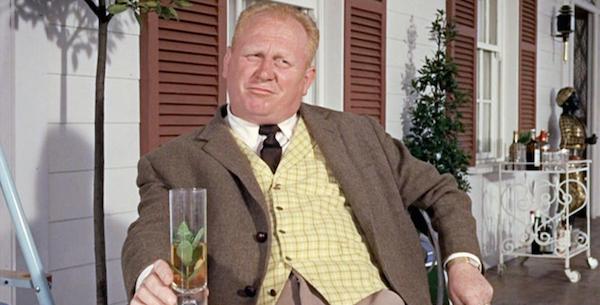
With the help of Goldfinger’s aide, the aforementioned Jill Masterson, Bond spoils the madman’s gin rummy game, but its Jill who pays the ultimate price. Covered head to toe in gold, resulting in “skin suffocation,” Jill succumbs to this cruel and unusual death, but not without leaving a legacy. For less than five minutes of screen time, Jill becomes the most memorable part of Goldfinger, and one of the most enduring images in pop culture. Kudos to her.
A Bond Villain is nothing without a Bond Henchman, and Oddjob is a suitable man for the part. As the inaugural henchman, Olympic wrestler Harold Sakata shines in the role, often quite literally. Diminutive in stature but invincible in strength, the decidedly mute Oddjob is all bright smiles and knowing looks, not to mention he’s equipped with a particularly deadly piece of headwear: his famously razor-brimmed bowler hat, capable of removing the head from a marble statue. As far as henchman go, Oddjob’s as deadly as they come.
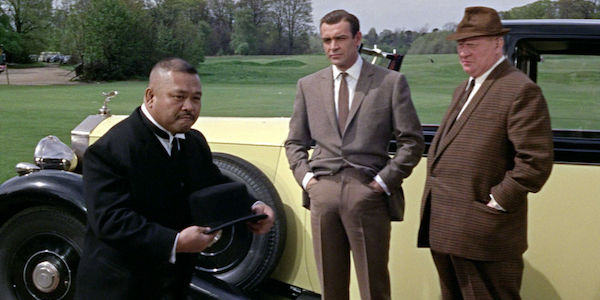
The leisurely-paced Golfing with Goldfinger sequence is one of my favorites in the franchise, primarily for how Bond uses his wits to best his foe. You know you’re in for a good time when you get to witness Bond engage in some light antagonism with his primary villain early on in the proceedings, and even more so when it’s a battle of wills, not strength. The switching of the golf balls is a bold move on Oddjob’s part, but the second switch by Bond is a stroke of genius. One can practically see the steam blowing out of Goldfinger’s ears once he realizes he’s been bested.
Do You Expect Me To Talk?
The re-introduction of Desmond Llewelyn as Q leads to the introduction to Q Labs, which becomes a recurring segment in the series (complete with the multitude of extras trying out equipment in the background as Q equips Bond for his mission). More importantly, it is here we also get the best car in the series: the Aston Martin DB5, armed with smokescreen, oil slick, machine guns, and a passenger ejector seat. Twenty plus cars later and none have been able to top the sheer awesomeness of the DB5.
The action moves over to Switzerland, where Bond gets to test drive his new wheels. While tailing Goldfinger, he encounters Tilly Masterson (Tania Mallet), who foolishly attempts to single-handedly avenge her sister’s death. The pair share a brief team-up, but it’s ruthlessly cut short by a swift throw from Oddjob’s hat, which is arguably a harsher death than Jill’s paint job.
The ensuing car chase is gratifying, if only because we get to see Bond tick off every single one of Chekhov’s I mean Q’s gadgets he had installed in the DB5. Bulletproof windows, blinding smokescreens, slippery oil slicks, and the glorious ejector seat: all get their moment in the sun. I do take some umbrage with the ultimate conclusion to the chase – Bond is defeated by a swerving to avoid a mirror – but that does lead to another personal favorite moment of Oddjob admiring his reflection in said mirror, so I suppose it’s just a small price to pay. Fortunately for us, Bond films give more than they take.
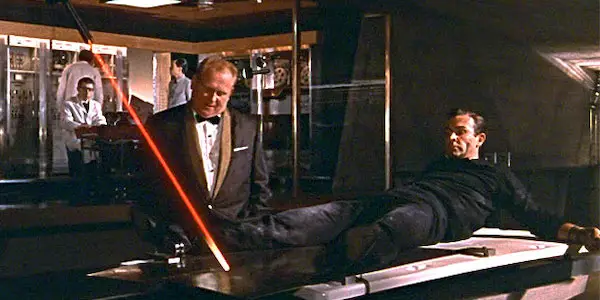
The Laser Scene is in the running for series’ greatest set-piece. Bond, strapped to a table, is forced to watch in fear as the laser threatens to slowly bisect him, starting from his manhood and moving upwards. A famous exchange with Goldfinger is held – “Do you expect me to talk?” “No, Mr. Bond, I expect you to die!” – and Bond is essentially done for. Thankfully, he manages to talk himself out of such a painful end, but this scene is atypical for Bond. Not that he won’t ever be placed in such a precarious scenario again – it’ll happen over and over – it’s just that when he does, he usually has something up his sleeve to the effect of a previously-established Q gadget to save the day. Here, he has nothing, and that’s a very important distinction.
After an exciting first half, the momentum slows down considerably in the second. This is not necessarily a bad thing; the deliberate pacing suits Connery’s Bond well, and we’re mostly in for the ride as Bond, now Goldfinger’s prisoner, becomes a mere observer to the action. Plus, we finally get to meet our last and arguably most crucial player in the game: Honor Blackman as Pussy Galore.
As the leader of her Flying Circus, Pussy Galore is as bold as everything else in the picture. A no-nonsense pilot and judo expert, Pussy is a fantastic character, one who is integral to both Goldfinger’s plot and to Bond saving the day. Pussy has the rare status of Bond Woman (Girl feels inappropriate here) who switches allegiances from villain to Bond, and she manages to transcends the silly name entirely to achieve legendary status. Once Bond is captured, the film really turns into Pussy’s movie, and I think it’s all the better for it (I should also mention: she’s coded as a lesbian, but that’s nothing a roll in the hay with Bond can’t fix. Yes, it does bother me too).
Speaking of, let’s discuss Goldfinger’s plot. As a deranged man with a burning obsession with acquiring gold (“I love its color, its brilliance, its divine heaviness”), Goldfinger’s target is Fort Knox, the largest gold reserve in the United States. Bond initially (and incorrectly) surmises that Goldfinger’s plan is to knock off Fort Knox to raid its gold supply, when in actuality he wants deposit a nuclear bomb inside to irradiate it and increase the value of his own gold tenfold. To get into the compound, Pussy Galore’s Flying Circus is to emit a deadly nerve gas to incapacitate 60,000 troops surrounding the area, granting Goldfinger and his army safe passage. Diabolical, no?
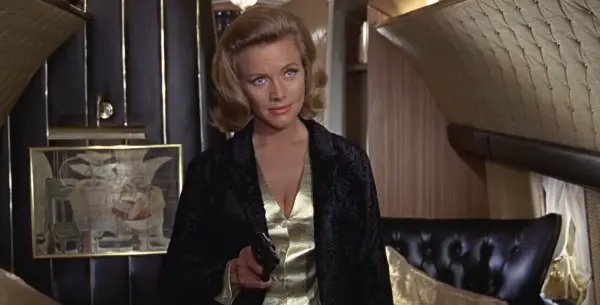
If that sounds crazy, get a load of this: Pussy, having switched allegiances over to Bond, replaces the Delta 9 gas cannisters with a harmless substitute, and has alerted the CIA to Goldfinger’s scheme. Their plan is to then have all of the surrounding soldiers play dead when the Flying Circus flies overhead, allow Goldfinger to get into Fort Knox, and activate a nuclear bomb inside of it before making their move to stop him. That’s arguably more insane than Goldfinger’s plot (and I’m not quite sure it holds water when looking back on it) but Bond films are better enjoyed when looking forward, and not dwelling too much time on the past.
The climax to Goldfinger is filled with excitement. Bond and Oddjob have an excellent knock-down-drag-out brawl in the bowels of Ken Adam’s gorgeously designed Fort Knox set, before the latter meets his own shocking end via his electrified hat. The US Army neutralizes the bomb, and Goldfinger is gruesomely sucked out of the shattered window of a depressurized airplane. Bond and Pussy have saved the day, and celebrate with some canoodling under a parachute.
Conclusion
What’s to be said about Goldfinger that hasn’t been said already? It truly is as radiant as the chemical element it takes its name after. It’s not quite the perfect film many claim it to be, but it is a perfect representation of what Bond is, and you would be hard-pressed to identify a film in the series that is filled with more iconic moments than this one.
Can Goldfinger be bested? In our next installment, SPECTRE returns to interrupt Bond’s vacation in an aquatic-heavy adventure. The No Time to Die Countdown will return with Thunderball.
What do you think? Is Goldfinger the perfect representation of James Bond?
Watch Goldfinger
Does content like this matter to you?
Become a Member and support film journalism. Unlock access to all of Film Inquiry`s great articles. Join a community of like-minded readers who are passionate about cinema - get access to our private members Network, give back to independent filmmakers, and more.
Movie lover & Los Angeles-based writer. BA in Film Criticism & Media Theory from CSU Northridge. Unofficial Bond ally. Rhymes with “tequila.”













